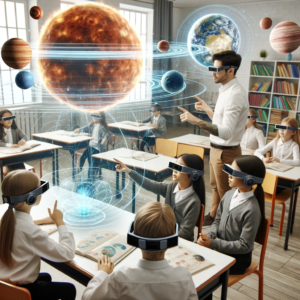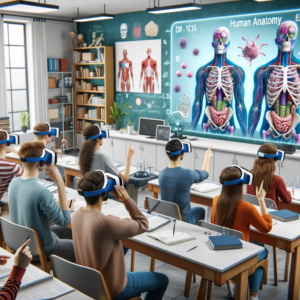The integration of augmented reality (AR) in education is revolutionizing the learning process, offering interactive and immersive experiences that were once the stuff of science fiction. This article delves into how AR is transforming traditional classrooms, enhancing learning outcomes, and preparing students for a future where digital and physical worlds coalesce.
Introduction to Augmented Reality in Education
Augmented reality, a technology that superimposes digital information onto the physical environment, is not just a tool for gamers or tech enthusiasts; it has become a significant player in the field of education. By overlaying text, images, or interactive data onto the real world, AR creates an enriched learning environment that is both engaging and educational.
Enhancing Learning Experiences
AR brings an element of excitement and novelty to the classroom. It turns abstract concepts into tangible experiences. For instance, students studying astronomy can explore the solar system in 3D, and biology students can dissect virtual frogs or explore the human body in detail. This hands-on approach caters to various learning styles and keeps students engaged and motivated.
Bridging the Gap between Theory and Practice
One of the most significant advantages of AR in education is its ability to bridge the gap between theoretical knowledge and practical application. For example, engineering students can visualize and interact with 3D models of machinery, while architecture students can walk through virtual models of their designs. This direct interaction with educational content fosters a deeper understanding of complex subjects.
Customized Learning Paths
AR enables personalized education. By using AR apps, students can learn at their own pace, revisit difficult concepts, or dive deeper into subjects of interest. This level of customization ensures that all students, regardless of their learning speed or style, can benefit from the curriculum.
Interactive Textbooks and Educational Material
The traditional textbook is being transformed by AR. Interactive textbooks with AR capabilities allow students to engage with the material in a more meaningful way. By scanning a page with a smartphone or tablet, students can see 3D models, animations, and supplementary information, making learning more dynamic and informative.

Collaborative Learning Environments
AR promotes collaboration among students. Through shared AR experiences, students can work together on projects, solve problems in real-time, and engage in collaborative learning activities. This not only enhances their learning experience but also helps develop important social and teamwork skills.
Accessibility and Inclusivity in Education
AR can make education more accessible and inclusive. Students with disabilities, particularly those with visual or auditory impairments, can benefit from AR technologies that adapt to their specific needs, providing them with the same educational opportunities as their peers.
Preparing Students for the Future
Incorporating AR into education prepares students for a future increasingly dominated by technology. By familiarizing students with AR, schools are equipping them with the skills and knowledge needed to navigate a world where digital and physical realities are intertwined.

The Global Reach of AR in Education
The impact of AR is not limited to affluent countries or well-funded schools. With the widespread availability of smartphones and tablets, AR has the potential to reach a global audience, providing quality educational experiences to students in remote or underprivileged areas.
Challenges and Considerations
Despite its benefits, the integration of AR in education faces challenges. The cost of AR technology and the need for robust internet connectivity can be barriers. Additionally, there is a need for comprehensive training for educators to effectively incorporate AR into their teaching methods.
Conclusion: A New Era of Learning
Augmented reality is more than just a technological innovation; it is a tool that has the potential to transform the educational landscape. By making learning more interactive, personalized, and accessible, AR is not only enhancing the way we educate but also preparing students for a future where the boundaries between the real and the virtual are increasingly blurred.
